
Line 1, shortened to L1, coloured red and often simply called Línia vermella, is the second oldest Barcelona Metro line, after line L3. It is the longest line of the Barcelona Metro, and links L'Hospitalet de Llobregat and Santa Coloma de Gramenet. Originally operated by the independent Ferrocarril Metropolitano Transversal de Barcelona, it is today operated by Transports Metropolitans de Barcelona (TMB) and is part of the ATM fare-integrated main transport system. L1 is the only metro line in Spain to use Iberian gauge tracks, as used by most Spanish main line railways.
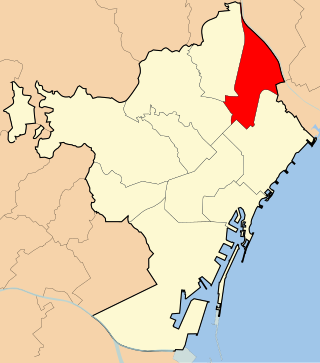
Sant Andreu is one of the ten districts of Barcelona since its redistricting in 1984. It was named after the former municipality of Sant Andreu de Palomar, which was the largest in the area and now makes up the bulk of the neighbourhood bearing its name, as well as part of the neighboring district of Nou Barris.

Trinitat Vella is the name of a station in the Barcelona metro network, currently served by the TMB-operated L1. It's named after the neighbourhood Trinitat Vella, in the Sant Andreu district of Barcelona, and the park of the same name. It is quite unusual in being one of the few stations with an attached building overground, which lies on the Nus de la Trinitat and links the neighbourhood with Parc de la Trinitat.
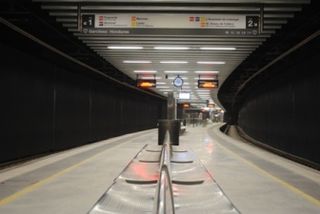
La Sagrera-Meridiana, simply known as La Sagrera, is an interchange complex underneath Avinguda Meridiana, in the Barcelona district of Sant Andreu, in Catalonia, Spain. It consists of a Rodalies de Catalunya station and three Barcelona Metro stations. The Rodalies de Catalunya station is located in the Meridiana Tunnel on the Lleida to Barcelona via Manresa railway, between Sant Andreu Arenal and Arc de Triomf, and is operated by Renfe Operadora. It is served by Barcelona commuter rail service lines R3 and R4, as well as regional rail line R12. The Barcelona Metro stations are on lines 1 (L1) and 5 (L5), as well as the northern section of line 9/10, and are operated by Transports Metropolitans de Barcelona (TMB). On the L1, the station is between Navas and Fabra i Puig, on the L5 between Camp de l'Arpa and Congrés, and on the L9/L10 between Plaça Maragall (future) and Sagrera - TAV. The station is also projected to become the terminus of the L4 once the extension from La Pau opens. A number of interurban bus services stop near the station.

Sagrera railway station is a major through station under construction in the Barcelona districts of Sant Andreu and Sant Martí, in Catalonia, Spain. It is intended to serve as the central station for northern and eastern Barcelona, with Sants serving as the central station for southern and western Barcelona. Together with El Prat de Llobregat and Sants, currently the only high-speed rail stations in the Barcelona area, it will be on the Madrid–Barcelona high-speed rail line. It will also be on the conventional Barcelona–Cerbère and Barcelona–Mataró–Maçanet-Massanes railways. Once fully completed, it will be a major public transport hub, with dedicated stations on Barcelona Metro lines 4 and 9/10, as well as a bus station. The complex will be fully underground excepting for the station building, with two levels of platforms, accounting for a total of 18 railway tracks.


The Barcelona–Vallès Line is an unconnected standard gauge rapid transit and commuter railway line linking Barcelona with Sabadell and Terrassa via the Collserola mountain range, in Catalonia, Spain. Its name refers to the Catalan historical region of Vallès, whereby most part of the line runs. Plaça de Catalunya station serves as the Barcelona terminus of the line, where almost all its trains either start or terminate. The line then continues northwards and branches off twice before leaving the city limits. Its main route splits in two in Sant Cugat del Vallès, forming two major branches to Sabadell and Terrassa. It has 40 passenger stations in operation and a total line length of 48.1 kilometres (29.9 mi).

El Poblenou is an extensive neighborhood of Barcelona that borders the Mediterranean Sea to the south, Sant Adrià del Besòs to the east, Parc de la Ciutadella in Ciutat Vella to the west, and Sant Andreu to the north. In the past the neighborhood was a town entirely separated from Barcelona.

Sant Andreu is a Rodalies de Catalunya station in the Sant Andreu district of Barcelona. It is served by Barcelona commuter rail service lines R2 and R2 Nord, as well as regional line R11. Passengers can also commute here to Barcelona Metro line 1 station Sant Andreu. It is located completely over ground.

Sant Andreu Arenal is a Rodalies de Catalunya station in the Barcelona district of Sant Andreu. It is served by Barcelona commuter rail lines R3, R4 and R7 as well as regional line R12. Passengers can also commute here to Barcelona Metro line 1 station Fabra i Puig and the Sant Andreu bus terminal. It is located where Avinguda Meridiana and Avinguda de Rio de Janeiro meet, by Rambla de Fabra i Puig.
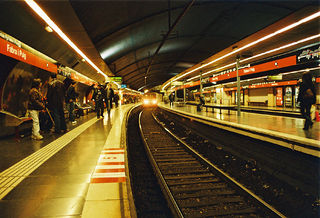
Fabra i Puig is a Barcelona Metro station, on L1, located in the Sant Andreu district of Barcelona, below Avinguda Meridiana between Carrer de Concepció Arenal i Passeig de Fabra i Puig. It opened in 1954, with the extension of the aforementioned line from Sagrera to this station. Passengers can commute here for the Renfe-operated Sant Andreu Arenal railway station. It's named after Passeig de Fabra i Puig, one of the main thoroughfares of the area.

Sant Andreu is a station of the Barcelona Metro network, served by line L1. Named after the neighbourhood of Sant Andreu de Palomar, in the Sant Andreu district of the city, the station was built in 1968 along with Fabra i Puig and Torras i Bages. It's interconnected with nearby railway station Sant Andreu Comtal.

Navas is a Barcelona Metro station located in the Sant Andreu district of Barcelona, served by L1. It opened in 1953. The name refers to carrer Navas de Tolosa, and the station was originally called Navas de Tolosa until it adopted its current name in 1982.
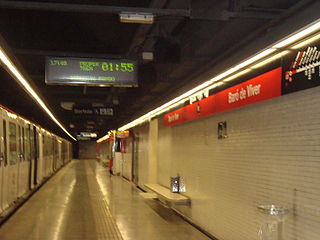
Baró de Viver is a station of the Barcelona Metro, in the Baró de Viver area of Sant Andreu, a northern district of Barcelona. It is operated by Transports Metropolitans de Barcelona (TMB) and served by L1. The station opened in 1983 as the line grew from its terminus in Torras i Bages towards the municipality of Santa Coloma de Gramenet. It is located under the southern side of the busy Nus de la Trinitat, next to the Besòs river bank.

The Llobregat–Anoia Line is an unconnected metre gauge railway line linking Barcelona with the Baix Llobregat, Bages and Anoia regions, in Catalonia, Spain. Its name refers to the fact that it follows the course of the Llobregat and Anoia rivers for most of its length. Plaça d'Espanya station serves as the Barcelona terminus of the line, then continuing northwards to Martorell, where two main branches to Manresa and Igualada are formed. It also includes several freight branches, accounting for a total line length of 138 kilometres (86 mi) and 41 passenger stations.

La Sagrera is a neighborhood of Barcelona.
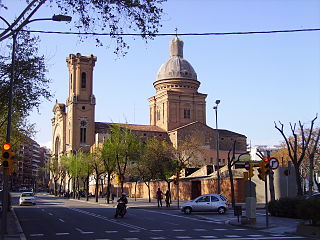
Sant Andreu de Palomar is a neighbourhood of Barcelona. It's the oldest part of the Sant Andreu district. It was an independent old town with over 1,000 years of recorded history before being annexed to Barcelona on 20 April 1897.

El Putxet i Farró is a neighbourhood in the Sarrià-Sant Gervasi district of Barcelona, Catalonia (Spain), located on a hill between Vallcarca and Sant Gervasi, urbanised after the 1870s. It is formed by two quarters, the former neighborhoods of el Putxet and el Farró.

The Cercle Artístic de Sant Lluc is an arts society which was founded in Barcelona (Catalonia) in 1893 by Joan Llimona, Josep Llimona, Antoni Utrillo, Alexandre de Riquer, the city councillor Alexandre M. Pons and a group of artists who were followers of bishop Josep Torras i Bages, as a reaction to the anticlerical current present in modernisme and in the Cercle Artístic de Barcelona, which they considered to be frivolous. The society was typified by its vigorous defence of Catholic morals and of family virtue, and its desire to follow in the path of humility that was pursued by the mediaeval guilds.



















